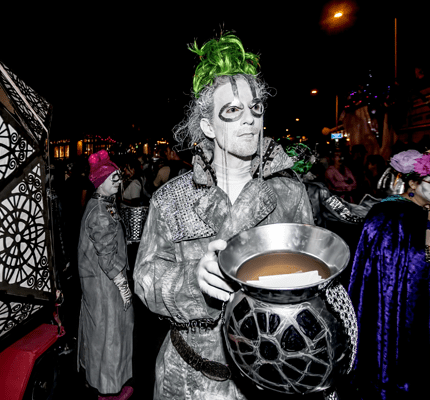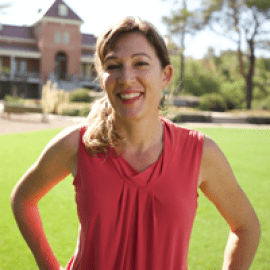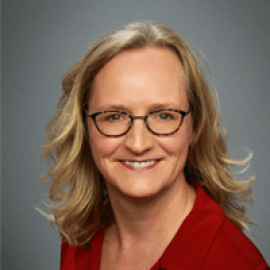
Framing the All Souls Procession in Tucson, Arizona
The All Souls Procession in Tucson, Arizona, is an iconic event for the Southwestern city. The Procession takes place in early November in downtown Tucson. According to its website, the event annually draws 150,000 participants seeking to celebrate and mourn lost loved ones and ancestors. Many consider the Procession the heart of Tucson’s sense of community. In a new article published in NCA’s Text and Performance Quarterly, Diana Daly and Catherine Brooks use ethnography to understand the Procession and its community through frames.
The All Souls Procession in Tucson, Arizona, event annually draws 150,000 participants seeking to celebrate and mourn lost loved ones and ancestors. Many consider the Procession the heart of Tucson’s sense of community.
Daly and Brooks define a frame as “a genre of performance (1) that cues (2) and channels participant behaviors (3) to replay the genre as a community expression (4).” The first criterion refers to how the performance and participation in it reflect a known genre or way of performing. The second criterion refers to how this frame cues participants to repeat it. The third criterion refers to how new behaviors become integrated into the frame; as an example, Daly and Brooks describe how political demonstrations have been incorporated into an event that was previously described as apolitical. The fourth criterion refers to how the community interprets and recreates these frames as performers, participants, and audience members.
The authors identified three small frames associated with the event: community ritual, inclusion, and Temporary Autonomous Zone. These smaller frames formed while organizers were able to train the performances of most participants. Daly and Brooks also identified two larger frames: Day of the Dead fantasy and parade. These larger frames grew as participants formed their own understandings of what the Procession should be.
Small Frames
The community ritual frame emphasizes that the Procession is inspired by Carl Jung’s exploration of rituals for therapy. Susan Johnson, an artist who organized the first Procession in 1990 to process her feelings following her father’s death, was trained in art therapy and had learned about Jung’s “work on collective rituals as ways to access deep feelings.” Through the shared ritual, community members produce art, perform solemn duties, and seek to bring the community together. For example, performers accept prayer slips to burn in large urns.
The inclusion frame has been emphasized almost from the beginning. After the first Procession, community members approached Johnson about holding a larger event. In 1991, Procession organizers applied for a grant and noted that the Procession was based on multiple cultural traditions:
Most cultural traditions include a fall processional celebration dedicated to harvest, ancestral death, and a decay which forebodes rejuvenation.…We wish to fashion a frame in which old and new cultural traditions will find processional expression.
Today, Procession publicity similarly emphasizes that everyone is welcome and that the event draws from a multitude of influences. The inclusion frame was especially prominent when the predominantly white organizers of first Processions first set out to include more Latinx community members.
The Temporary Autonomous Zone (TAZ) frame helped organizers negotiate space for the growing event and honor its disappearing past. TAZ is both the title of an anarchist book and a term that means “an uprising which does not engage directly with the State, a guerilla operation which liberates an area (of land, of time, of imagination) and then dissolves itself to re-form elsewhere/elsewhen, before the State can crush it.” The organizers who took over the Procession after Johnson emphasized its “guerilla” and “unsanctioned” nature. The TAZ perspective influenced the energy that the performers invoked in their performance by using public space for art, a performer who is now part of MMOS said in an interview: “It’s really important that it’s out in the public sphere…it absolutely is political because that space doesn’t belong to us.”
Larger Frames
The Day of the Dead fantasy frame addresses the complicated relationship between the All Souls Procession and Day of the Dead, the anglicized term for Día de los Muertos. Johnson, the organizer of the first Procession, acknowledges that Day of the Dead was an influence on the Procession. However, when later organizers met to make the Procession more inclusive in the mid-1990s, they also discussed “cultural appropriation…because the Latino community was really not represented,” and since then have distanced the event from association with Día de los Muertos. Still, today increasing numbers of participants use imagery related to Day of the Dead, such as calaveras, or decorated skulls. Many couples dress as a skeletal bride and groom, performing fantasies about retaining gender and sexuality after death. While the Procession website declares that the event is not a Día de los Muertos parade, the Day of the Dead fantasy is present through participants’ costumes and artwork. Recent Processions have been organized to pass through Latinx neighborhoods and have included political activism directed at U.S. immigration policies. The authors argue that the “fantasy performed through the Day of the Dead fantasy frame in recent years reflects a community imaginary, of Tucson as a border culture steeped in Latinidad beyond simple fantasies of calaveras and morbid Mexicans.”
The parade frame ties into U.S. cultural traditions of parades. The MMOS website, however, addresses the differences between the nature of the Procession and that of a typical U.S. parade:
The All Souls Procession is not a parade as parade is commonly defined. Usually, when you think of a parade it’s a bunch of pre-registered, fee-paying floats and groups that walk down the middle of the road while everyone else stands on the sidelines and watches. The Procession is pretty much the exact opposite of that! It’s a full-participation, attendee-created event. Everyone is welcome in the streets.
Despite organizers’ insistence that the Procession is not a parade, online reviews show participants consider the event a parade, and recent Processions include many elements of traditional parades, such as marching bands. Still, Procession organizers eschew typical notions of a parade through spontaneity, such as by straying off-course and incorporating participation from community members.
Frames and Community
Daly and Brooks conclude by discussing how the small frames guided the Procession in its early years, while today, many participants invoke the Day of the Dead fantasy and parade frames through their performances. Daly and Brooks acknowledge that they focused on frames that stood out to them, although many more likely exist. The authors argue that the participants perform “overlapping frames” that build community through the Procession, and that this theory of frames can apply to many other participatory events.



